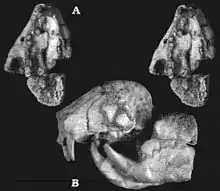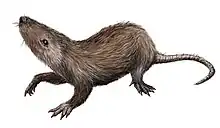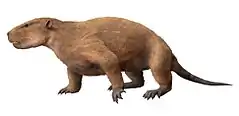Kryptobaatar
Kryptobaatar,[1] also known as Gobibaatar[1] or Tugrigbaatar,[2] is an extinct mammalian genus dating from the Upper Cretaceous Period and identified in Central Asia. This animal was a member of the extinct order of Multituberculata within the suborder Cimolodonta, and was a member of the family Djadochtatheriidae. It lived contemporaneously with some of the dinosaurs. Its skull had a length of perhaps 3 cm.
| Kryptobaatar Temporal range: Campanian-Maastrichtian | |
|---|---|
 | |
| Kryptobaatar dashzevegi | |
| Scientific classification | |
| Domain: | Eukaryota |
| Kingdom: | Animalia |
| Phylum: | Chordata |
| Class: | Mammalia |
| Order: | †Multituberculata |
| Family: | †Djadochtatheriidae |
| Genus: | †Kryptobaatar |
| Species | |
| |
| Synonyms | |
| |
The generic name Kryptobaatar is derived from Greek κρυπτός: kruptós, "hidden," (alludes to the ventral position of infraorbital foramen) and Mongolian баатар: baatar, "hero" (alludes to the name of the capital of Mongolia, Ulan Baatar). The specific name dashzevegi is named in honour of Mongolian palaeontologist Demberelyin Dashzeveg. The derivation of its synonym Gobibaatar parvus is Gobi (occurring in the Gobi Desert, Mongolia) and baatar ("a hero", the same as Kryptobaatar).[1] Another synonym Tugrigbaatar saichanensis is a generic name derived from the Toogreeg and Ulan Baatar, and a specific name derived from a Gurvan Saykhan mountain range.[3]
Species identified

- Kryptobaatar dashzevegi Kielan−Jaworowska, 1969. At Djadokhta Formation, Ukhaa Tolgod, Tögrög Shiree and Bayan Zag or Baruungoyot Formation, Red beds of Hermiin Tsav, Mongolia. Stage: lower Campanian or Upper Cretaceous. The skull has a length of perhaps 3 cm. The front teeth look impressively sharp and not much like those of a strict vegetarian. Gobibaatar parvus Kielan−Jaworowska, 1969 and Tugrigbaatar saichanensis Kielan−Jaworowska & Dashzeveg, 1978 are now treated as synonyms of K. dashzevegi by Kielan-Jaworowska et al. (2003).[4]
- Kryptobaatar mandahuensis Smith, Guo & Sun, 2001. At Bayan Mandahu Formation, Urad Houqi Banner, Inner Mongolia, China. Based on several well-preserved skulls. This location is about the same stage as the Djadokhta Formation of Mongolia, Campanian (Upper Cretaceous).[4]
Biology
Kryptobaatar was a hopping species, similar to a modern Jerboa.[5] It is thought to have been a carnivory-oriented omnivore.[6][7]
Notes
- Kielan-Jaworowska 1969, pp. 35–49.
- "Gobibaatar has page priority but was selected as the junior synonym by Kielan-Jaworowska in 1980," (McKenna & Bell, 1997)
- Kielan-Jaworowska and Dashzeveg 1978, pp. 115–134.
- Kielan-Jaworowska et al. 2003, pp. 273–278.
- Meng Chen, Gregory Philip Wilson, A multivariate approach to infer locomotor modes in Mesozoic mammals, Article in Paleobiology 41(02) · February 2015 doi:10.1017/pab.2014.14
- Wilson GP, Evans AR, Corfe IJ, Smits PD, Fortelius M, Jernvall J. 2012Adaptive radiation of multituberculate mammals before the extinction of dinosaurs. Nature 483, 457-460. (doi:10.1038/nature10880)
- Adams, Neil F.; Rayfield, Emily J.; Cox, Philip G.; Cobb, Samuel N.; Corfe, Ian J. (2019). "Functional tests of the competitive exclusion hypothesis for multituberculate extinction". Royal Society Open Science. 6 (3): 181536. Bibcode:2019RSOS....681536A. doi:10.1098/rsos.181536. PMC 6458384. PMID 31032010.
References
- Kielan-Jaworowska Z & Hurum JH (2001), "Phylogeny and Systematics of multituberculate mammals". Paleontology 44, p. 389-429.
- McKenna MC & Bell SK, (1997), Classification of Mammals Above the Species Level. Columbia University Press.
- Kielan-Jaworowska, Zofia (1969). "New Upper Cretaceous multituberculate genera from Bayn Dzak, Gobi Desert" (PDF). Results of the Polish-Mongolian Palaeontological Expeditions, Pt. II. Palaeontologica Polonica. 21: 35–49.
- Kielan−Jaworowska, Zofia; Dashzeveg, Demberlyin (1978). "New Late Cretaceous mammal locality in Mongolia and a description of a new multituberculate". Acta Palaeontologica Polonica. 23 (2).
- Kielan−Jaworowska, Zofia; Hurum, Jørn H.; Badamgarav, Demchig (2003). "An extended range of the multituberculate Kryptobaatar and distribution of mammals in the Upper Cretaceous of the Gobi Desert" (PDF). Acta Palaeontologica Polonica. 48 (2): 273–278.
- WIBLE, JOHN R.; ROUGIER, GUILLERMO W. (February 2000). "Cranial anatomy of Kryptobaatar dashzevegi (Mammalia, Multituberculata), and its bearing on the evolution of mammalian characters". Bulletin of the American Museum of Natural History. 247: 1–120. doi:10.1206/0003-0090(2000)247<0001:CAOKDM>2.0.CO;2. S2CID 82849991.

